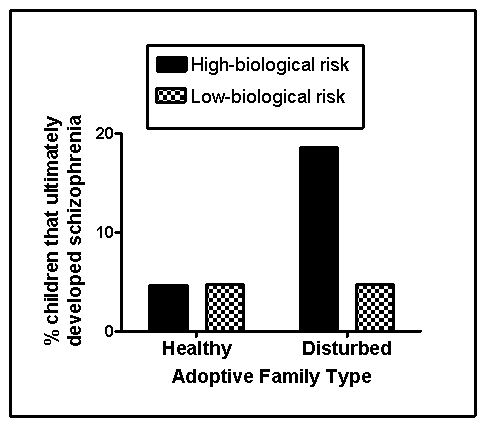Use the following to answer questions
Scenario II
The following scenario presents fabricated data consistent with the results of the following study:
Tienari,P. ,Wynne,L.C. ,Sorri,A. ,Lahti,I. ,Läksy,K. ,Moring,J. ,& ...Wahlberg,K.(2004) .Genotype-environment interaction in schizophrenia-spectrum disorder: Long-term follow-up study of Finnish adoptees.The British Journal of Psychiatry,184(3) ,216-222.doi:10.1192/bjp.184.3.216
Schizophrenia affects approximately 1% of the general population and is characterized by the profound disruption of basic psychological processes;a distorted perception of reality;altered or blunted emotional affect;and disturbances in thought,motivation,and behavior.The symptoms of schizophrenia are varied and are typically classified as either positive or negative.Positive symptoms of schizophrenia refer to thoughts and behaviors typically not observed in those without the disease and can include things like delusions (patently false beliefs) ,hallucinations (false perceptual experiences) ,and disorganized speech.Negative symptoms of schizophrenia are deficits or disruptions in normal behaviors,such as social withdrawal.Cognitive deficits in executive functioning,attention span,and working memory may also be observed.
The symptoms of schizophrenia usually begin in late adolescence and the disease has a strong genetic component.Over the years,a number of biological factors have been linked to schizophrenia,although none alone adequately accounts for the disorder.One such example is the dopamine hypothesis,which states that schizophrenia is related to an excess in dopamine activity.Another theory points to enlarged brain ventricles and progressive cortex tissue loss as predictive of schizophrenia.Although only a minority of persons with schizophrenia have enlarged ventricles,this structural anomaly can appear in those without the disease,and dopamine antagonists may also produce this effect.
Although research into the environmental determinants of schizophrenia has focused largely on the prenatal environment,psychological and social factors also contribute.Tienari and colleagues (2004) compared the risk of developing schizophrenia in children adopted into healthy versus disturbed families,the latter characterized by extreme conflict,volatile relationships,and communication deficits.Some of these children under investigation were identified as at-risk genetically for schizophrenia because their biological mothers were schizophrenic.The remainder were classified at low risk.The investigators utilized a longitudinal design and obtained the diagnostic status of the children with respect to schizophrenia when they reached young adulthood.Fabricated results consistent with this study are shown in Figure 15.2
Figure 15.2 
-(Scenario II) The dopamine hypothesis of schizophrenia was developed in large part due to research on the effects of psychoactive drugs in the brain.Which statement does that research NOT support?
Definitions:
Bulimia Nervosa
An eating disorder characterized by episodes of binge eating followed by behaviors aimed at preventing weight gain, such as self-induced vomiting.
Anorexia Nervosa
A mental health disorder characterized by an intense fear of gaining weight and a distorted body image, leading to severe weight loss and health complications.
Life-Threatening
A term used to describe diseases, conditions, or situations that pose a serious risk to an individual's health and have the potential to result in death.
Adaptive Behaviour
Adaptive behaviour refers to the set of skills individuals learn and use to function and meet daily life demands, including social and practical skills.
Q5: Which strategy is probably the MOST effective
Q15: It is probably easier to deal with
Q15: Which mental health professional would be MOST
Q27: In their research on the role of
Q52: Common assays used to determine if infants
Q128: A key physiological event in the cascade
Q135: Delores suffers from Parkinson's disease and has
Q138: Pat finds herself worrying about most things
Q183: Which statement does NOT describe an advantage
Q202: Which treatment for psychological problems is MOST